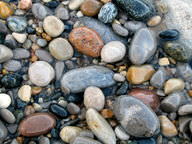13.2机械风化
章节大纲
-
Lesson
::经验教训Why is mechanical weathering so important here?
::为什么机械风化在这里这么重要?The high mountains of the Sierra Nevada are made of granite. The climate is cold. Mechanical weathering dominates the weathering here. Can you find signs of mechanical weathering in the photo? Can you see evidence of in the photo? Why is mechanical weathering so much more important than chemical weathering here? How is mechanical weathering altering the landscape in the high Sierra?
::高山的内华达山脉是由花岗岩组成的。 气候寒冷。 机械天气控制着这里的天气。 你能在照片中找到机械天气的迹象吗 ? 你能看到照片中的证据吗? 为什么机械天气比化学天气更重要? 机械天气如何改变高山的地形?Mechanical Weathering
::机械气象学Mechanical weathering breaks into smaller pieces. These smaller pieces are just like the bigger rock; they're just smaller! The rock has broken without changing its composition. The smaller pieces have the same in the same proportions. You could use the expression “a chip off the old block“ to describe mechanical weathering! The main agents of mechanical weathering are water , ice, and wind .
::机械气象破碎成小块。 这些小块和大块岩石一样; 它们只是小块! 岩石碎裂时没有改变其构成。 小块的形状相同。 您可以使用“ 旧块上的芯片” 来描述机械气象学。 机械气象学的主要动力是水、 冰和风。Ice Wedging
::冰 冰 结 织Rocks can break apart into smaller pieces in many ways. Ice wedging is common where water goes above and below its freezing point ( Figure ). This can happen in winter in the mid-latitudes or in colder climates in summer. Ice wedging is common in mountainous regions like the Sierra Nevada pictured above.
::岩石在许多方面可以分裂成小块。 在冰层中水位高于或低于其冰层点的地方,冰层结扎很常见(图 ) 。 这可以在冬季发生于中纬度或夏季更寒冷的气候中。 冰层结扎在上文所描绘的内华达山脉等山区是常见的。Diagram showing ice wedging. This is how ice wedging works. When liquid water changes into solid ice, it increases in volume. You see this when you fill an ice cube tray with water and put it in the freezer. The ice cubes go to a higher level in the tray than the water. You also may have seen this if you put a can of soda into the freezer so that it cools down quickly. If you leave the can in the freezer too long, the liquid expands so much that it bends or pops the can. (For the record, water is very unusual. Most substances get smaller when they change from a liquid to a solid.)
::这就是冰结是如何工作的。 当液体水变成固体冰时,它会增加体积。 当你用水填满一个冰块托盘并将其放入冷冻室时, 你可以看到这一点。 冰块在托盘中进入比水更高的水平。 如果在冷冻室里放一罐苏打水, 这样它就能很快地冷却下来。 如果你把罐子留在冰柜里的时间过长, 液体会膨胀到如此之大, 它会弯曲或爆开罐子。 (据记录, 水是非常不寻常的。 当它们从液体变成固体时, 大多数物质会变小。 )Ice wedging happens because water expands as it goes from liquid to solid. When the is warm, water works its way into cracks in rock. When the temperature cools below freezing, the water turns to ice and expands. The ice takes up more space. Over time, this wedges the rock apart. Ice wedging is very effective at weathering. You can find large piles of broken rock at the base of a slope. These rocks were broken up by ice wedging. Once loose, they tumbled down the slope.
::织冰之所以发生,是因为水从液体到固体时会膨胀。当水变暖时,水会演变成岩石裂缝。当温度在冰层下冷时,水会变成冰块和膨胀。冰会占用更多的空间。随着时间推移,冰会把岩石分开。冰会非常有效地进行风化。你可以在坡底找到大量的碎石。这些岩石是被冰层结冰而碎的。一旦松散,它们就会滑落到斜坡上。Abrasion
::面部Abrasion is another type of mechanical weathering. With abrasion, one rock bumps against another rock. Gravity causes abrasion as a rock tumbles down a slope. Moving water causes abrasion; it moves rocks so that they bump against one another ( Figure ). Strong winds cause abrasion by blasting sand against rock surfaces. Finally, the ice in cause abrasion. Pieces of rock embedded in ice at the bottom of a glacier scrape against the rock below. If you have ever collected beach glass or pebbles from a stream , you have witnessed the work of abrasion.
::磨损是另一种机械式的天气。 磨损后, 一块岩石会撞到另一块岩石。 重力会使一块岩石的磨损像塌塌的斜坡一样。 移动水会引发磨损; 移动岩石会相互碰撞( Figure ) 。 强风会把沙子轰到岩石表面造成磨损 。 最后, 冰会引发磨损 。 冰会将一块岩石埋在冰中, 冰会从冰川底部刮到下面的岩石上。 如果你从溪流中收集到海滩玻璃或石块, 你就会亲眼看到磨损的结果 。Water flowing through river or beach cobbles causes them to hit each other. This contact causes abrasion, which makes the rocks round. Plants and Animals in Mechanical Weathering
::机械气象中的植物和动物Sometimes plants or animals cause mechanical weathering. This can happen slowly. A plant’s roots grow into a crack in rock. As the roots grow larger, they wedge open the crack ( Figure ). Burrowing animals can also cause weathering. By digging for food or creating a hole to live in, the animal may break apart rock.
::有时,植物或动物会造成机械天气。这可以慢慢发生。植物的根部会发展成岩石裂缝。随着根部变大,它们会裂开裂缝(图 ) 。 埋设动物也会引发天气。 通过挖掘食物或创造洞洞,动物可能会分裂岩石。The large roots of this tree can break apart rock. This is mechanical weathering. Humans and Mechanical Weathering
::人类和机械气象Today, human beings do a lot of mechanical weathering whenever we dig or blast into rock. This is common when we build homes, roads, and subways, or quarry stone for construction or other uses.
::今天,每当我们挖掘或轰炸岩石时,人类都会做很多机械风化工作。 当我们建造房屋、道路和地铁,或者用于建筑或其他用途的采石石时,这很常见。Summary
::摘要- Mechanical weathering breaks down existing rocks and minerals.
::机械风化打破了现有的岩石和矿物。
- Mechanical weathering keeps the chemical makeup of materials the same.
::机械风化使材料的化学成分保持不变。
- Ice wedging, abrasion, and some actions of living organisms and humans bring about mechanical weathering.
::冰结、磨损 以及活生物体和人类的一些行为 带来了机械的风化
Review
::回顾- Describe the process of ice wedging. In what environment is ice wedging most likely to happen?
::描述冰结的过程。 在什么环境中最有可能发生冰结?
- Describe the process of abrasion.
::描述擦伤过程。
- How do plants and animals cause mechanical weathering?
::植物和动物如何导致机械风化?
- Mechanical weathering breaks down existing rocks and minerals.



